Mehr Informationen unter: https://www.iais.fraunhofer.de/de/branchen-themen/themen/intelligente-prozessautomatisierung/gen-ai-robotersteuerung.html
Archiv der Kategorie: Programming
Spielerische Robotik-Ausbildung: igus Low-Cost-Automation bewährt sich im Schulalltag
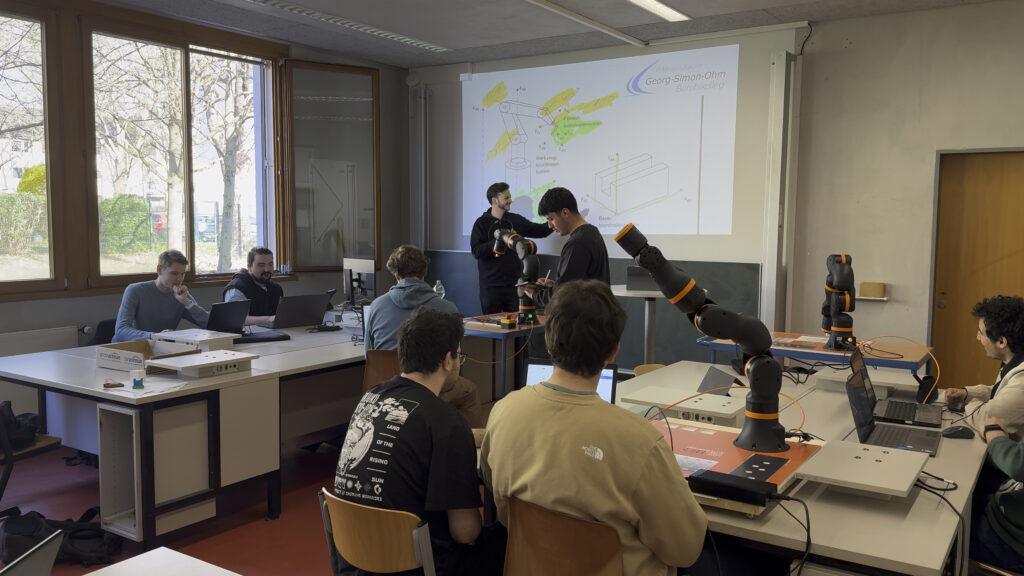
Georg-Simon-Ohm-Berufskolleg setzt auf ReBeL Cobots und Education Kits von igus, um Schülern einen einfachen Einstieg in die Roboter-Programmierung zu ermöglichen
Köln, 17. Juni 2025 – Junge Menschen für Technik begeistern: Dieses Ziel verfolgt der Kunststoffspezialist und Robotikhersteller igus mit seinen Bildungsangeboten speziell für Schulen, Hochschulen und Universitäten. Dazu zählt auch das ReBeL Education Kit: Ein Lernpaket, das Schülern und Studierenden den spielerischen Einstieg in die Robotik mithilfe des ReBeL Cobots ermöglichen soll. Zum Einsatz kommen die Education Kits unter anderem am Georg-Simon-Ohm-Berufskolleg in Köln. So bekommen die Schüler die Möglichkeit, erste Programmierkenntnisse zu erwerben und praxisnahe Anwendungen zu erproben.
Von Elektrotechnik über Datenbankwissen bis hin zur Softwareentwicklung: Die Ausbildung zum Informationstechnischen Assistenten am Georg-Simon-Ohm-Berufskolleg in Köln umfasst ein vielseitiges Lehrprogramm. Dazu gehört auch das Programmieren von Robotern, um den Schülern besondere Qualifikationen in der Automatisierungstechnik zu vermitteln. „Für unsere Robotik-Klasse kamen bisher humanoide Robotiksysteme zum Einsatz, die jedoch mit der Zeit störungsanfällig geworden sind“, erklärt Kevin Meyer, Lehrer für Elektrotechnik und Robotik am Georg-Simon-Ohm-Berufskolleg. „Daher brauchten wir Ersatz für die alten Systeme und haben uns gezielt auf die Suche nach Roboterarmen gemacht, die einfach zu bedienen sind und realitätsnahe Anwendungsszenarien ermöglichen.“ Fündig wurde das Berufskolleg schließlich beim Kölner Kunststoffspezialisten igus.
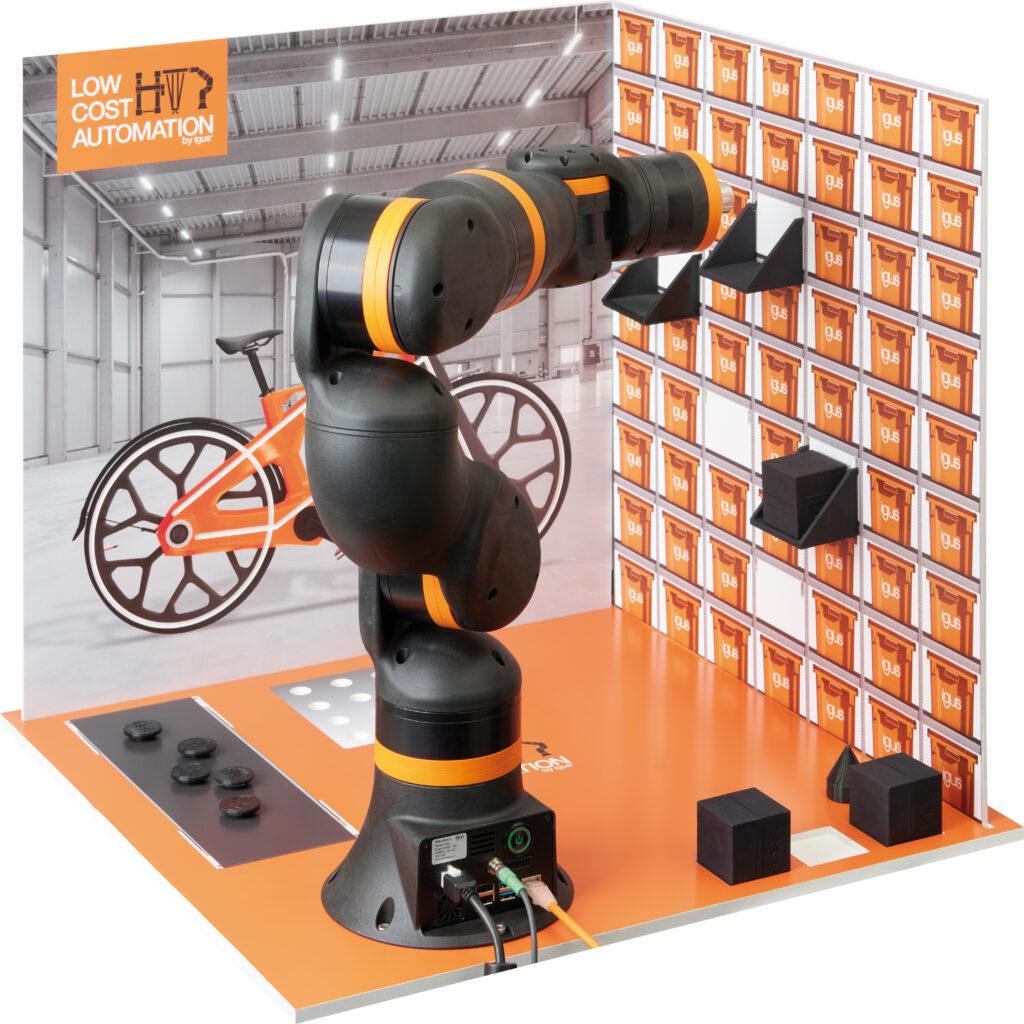
Programmieren lernen mit realitätsnahen Anwendungsbeispielen
„igus war uns bereits für seine Energieketten bekannt, doch bei unserer Suche sind wir dann auch auf das Low-Cost-Automation-Angebot gestoßen und haben gleich einen Beratungstermin vor Ort ausgemacht“, erzählt Kevin Meyer. Auf der 400 Quadratmeter großen Customer Test Area können Kunden zahlreiche Automationslösungen aus der Praxis in Aktion sehen und gemeinsam mit den Robotik-Experten von igus die Machbarkeit ihrer geplanten Anwendung testen. Die Wahl fiel schließlich auf zehn ReBeL Cobots mit sechs Achsen inklusive Education Kits. „Roboter gibt es auf dem Markt zwar viele, aber die Alternativen waren für unsere Zwecke entweder zu klein oder zu teuer. Zudem war für uns auch eine leichte Bedienbarkeit wichtig.“ Der ReBeL Cobot mit einem Gewicht von nur 8,2 Kilogramm, einer Traglast von zwei Kilogramm und einer Reichweite von 664 Millimetern ist in der vollausgestatteten Plug-and-Play-Variante bereits für 4.970 Euro erhältlich. Im Education Kit enthalten sind über 100 Stunden Lernmaterial und Projektplatten, die auf eine Arbeitsfläche montiert werden. Anhand derer lassen sich unterschiedliche Szenarien mit Realitätsbezug programmieren: ob Behälter in ein Hochregal sortieren, Bauteile eines Fahrrads vom Förderband nehmen und an der entsprechenden Stelle einsetzen oder die Qualitätskontrolle am Fahrrad. Die kostenlose und lizenzfreie igus Robot Control Software ermöglicht zudem eine einfache Bedienbarkeit und erleichtert den Einstieg in die Roboterprogrammierung.
Lernende gezielt auf die moderne Arbeitswelt vorbereiten
Die ReBeL Cobots und Education Kits sind inzwischen seit einem Jahr in vier Robotik-Klassen des Berufskollegs im Einsatz. „Die meisten Schüler arbeiten sehr gerne mit den Robotern. Die Bedienung war am Anfang für manche noch eine Herausforderung, aber am Ende haben es alle geschafft“, erzählt Kevin Meyer. Die Software sei visuell sehr anschaulich und ermögliche den Schülern, schnell kleine Fortschritte zu machen. Alexander Mühlens, Leiter Geschäftsbereich Low-Cost-Automation bei igus betont: „Uns liegt die Förderung des Roboternachwuchses sehr am Herzen, daher freuen uns solche Projekte immer besonders. Mit unserem breiten Bildungsangebot möchten wir Schulen, Hochschulen und Universitäten dabei unterstützen, theoretisches Wissen praxisnah zu vermitteln und Lernende gezielt auf die moderne Arbeitswelt vorzubereiten.“
Mehr Informationen zum Robotik-Bildungsangebot von igus finden Sie hier:
KI-Gestenerkennung mit IDS NXT Kamera lässt igus ReBel Roboter Stein, Schere, Papier gegen Mensch spielen
RobotCtrl: Einfachere Steuerung für alle Robotik-Hersteller

Die igus Steuerungssoftware für herstellerunabhängige Robotik wächst – Lebai, Hitbot und Lynx Motion jetzt verfügbar
Köln, 3. Juni 2025 – Automatisierung muss nicht kompliziert sein – mit RobotCtrl wird sie für Unternehmen jeder Größe noch zugänglicher. Durch die intuitive Steuerungssoftware von igus lassen sich auf dem Online-Robotik-Marktplatz RBTX erhältliche Roboter unabhängig vom Hersteller einheitlich bedienen und Zubehör wie Kameras, Greifer oder Roboterzellen integrieren. Damit reduziert RobotCtrl die Bedienungskomplexität und den Integrationsaufwand für Einsteiger und Profis erheblich. Neu hinzugekommen ist die Unterstützung der Robotikhersteller Lebai, Hitbot und Lynx Motion.
Als führender Marktplatz für Robotik und Automatisierung vereint RBTX über 175 Anbieter und mehr als 850 Roboter und Komponenten an einem Ort. Ob Greifer, Sensoren oder komplette Robotersysteme – hier finden Interessierte alles, was sie für ihre Automatisierung benötigen. Mit der von igus entwickelten RobotCtrl wird die Integration und Steuerung von Low-Cost-Automatisierung noch flexibler und einfacher als je zuvor. Auf RBTX erhältliche Roboter können mit der Software einheitlich programmiert und gesteuert werden. Nutzer profitieren von einer verringerten Einarbeitungszeit, da sie nur eine einzige Software beherrschen müssen. Die Möglichkeit, Roboter verschiedenster Hersteller mit nur einer Steuerung zu programmieren, spart allerdings nicht nur Zeit und Schulungskosten, sondern eröffnet Unternehmen auch neue Möglichkeiten für eine herstellerunabhängige Automatisierungsstrategie. Dank des modularen Aufbaus unterstützt RobotCtrl verschiedene Roboterkinematiken unterschiedlicher Hersteller, darunter igus, Fanuc, KUKA und viele mehr. Dies ermöglicht eine nahtlose Integration verschiedener Robotiksysteme in bestehende Produktions- und Automatisierungslösungen. Die Bewegungsabläufe der Roboter können auf einer 3D-Oberfläche simuliert werden – ohne dass der Roboter physisch angeschlossen sein muss. „Dies erleichtert die Planung und Entwicklung neuer Prozesse und ermöglicht es Automatisierungsstrategien effizient zu testen bevor sie in die Praxis umgesetzt werden“, macht Alexander Mühlens, Leiter Geschäftsbereich Low-Cost-Automation bei igus, deutlich. „Unternehmen können somit schneller auf Marktanforderungen reagieren, Produktionsprozesse effizienter gestalten und so Kosten sparen.“
Roboter-Programmierung leicht gemacht
RobotCtrl wurde bereits erfolgreich mit führenden Herstellern getestet. Nutzer können somit sicher sein, dass sie mit einer bewährten und zuverlässigen Software arbeiten. Ein weiterer Vorteil von RobotCtrl ist die benutzerfreundliche grafische Oberfläche, die eine intuitive Programmierung erlaubt. Dank einer Drag-and-Drop-Funktion können Bewegungsabläufe einfach erstellt und angepasst werden. Dies reduziert den Programmieraufwand und macht die Software auch für Anwender ohne tiefgehende Programmierkenntnisse leicht verständlich. Besonders für kleine und mittelständische Unternehmen, die bisher vor der Komplexität der Robotik zurückgeschreckt sind, bietet RobotCtrl eine praxisnahe und kosteneffiziente Lösung. „Unser Ziel ist es, Automatisierung so einfach und zugänglich wie möglich zu gestalten“, stellt Alexander Mühlens heraus. „Mit RobotCtrl ermöglichen wir Unternehmen jeder Größe, einen kostengünstigen und flexiblen Einstieg in die Automatisierung.“
Weitere Informationen zu RobotCtrl und mehr als 650 erfolgreich durchgeführte Anwendungsbeispiele finden sich auf der Plattform RBTX: rbtx.com
BerryBot: STEM Education for Young Engineers with a wooden robot
Robotistan, a pioneer in innovative educational solutions, has introduced a new STEM robot called BerryBot. Designed to help children develop coding and robotics skills, this creative and educational robot offers practical experiences in science, technology, engineering, and mathematics (STEM).

A New Era in Robotics Education
BerryBot is more than just a robot; it’s a learning platform that nurtures creativity and problem-solving skills. With its compact and customizable design, BerryBot allows users to paint and personalize their robot, thanks to its wooden body.
The wooden structure not only reflects an eco-friendly design approach but also allows children to shape their robots according to their own style. BerryBot is designed to be flexible enough for both classroom and home use.

Key Features
BerryBot’s innovative features support the development of both technical and creative skills:
- Customizable Wooden Body:
- Kids can paint their robots to reflect their unique style.
- Durable and sustainable construction.
- Versatile Coding Options:
- Block-based programming for beginners.
- Advanced programming with Python and Arduino IDE.
- User-friendly interface for an easy learning process.
- Multi-Mode Movement:
- Line-following, sumo, and free movement modes.
- Real-time visual feedback via the LED matrix display.
- Wireless control through Bluetooth connectivity.
An Educational Tool Combining Coding Skills with Creativity
BerryBot offers young aspiring engineers a fun and educational experience. While creating different movement scenarios, children not only enhance their problem-solving skills but also develop creative projects.
Thanks to BerryBot’s multi-mode structure, users can program the robot’s movement capabilities in various ways. This feature transforms BerryBot from being just a toy to a valuable educational tool that encourages creative thinking.
Mehmet Akçalı, Marketing and Product Director at Robotistan, highlighted the educational features of BerryBot:
„BerryBot offers a practical and fun way for children to step into the world of STEM. Combining coding skills with creative projects, this robot will become an indispensable educational tool for both teachers and parents.“
He also mentioned a special opportunity for early supporters:
„We’re thrilled to announce our Kickstarter campaign, where backers can take advantage of the Early Bird offer. Additionally, as part of our commitment to supporting STEM education, for every 10 pledges, we will gift one BerryBot to a school or an educational organization in need. This way, our supporters not only get an amazing educational robot but also help inspire the next generation of young innovators.“
Shaping the Engineers of the Future
As the importance of STEM education continues to grow, innovative tools like BerryBot are preparing young minds for the future. With its fun yet educational nature, BerryBot strengthens children’s coding, algorithmic thinking, and problem-solving skills while also inspiring creative projects.
Robotistan emphasizes that BerryBot is not just an educational robot but also a platform where children can express themselves. Produced with this vision in mind, BerryBot is ready to make a difference both at home and in educational environments.

To learn more about BerryBot and to be among the first to own it and take advantage of the Early Bird offer, visit the Kickstarter page!
Roboter automatisiert Pick-and-Place-Prozesse mit KI-gestützter Bildverarbeitung
Pick-and-Place-Anwendungen sind ein zentrales Einsatzgebiet der Robotik. Sie werden häufig in der Industrie genutzt, um Montageprozesse zu beschleunigen und manuelle Tätigkeiten zu reduzieren – ein spannendes Thema für Informatik Masteranden des Instituts für datenoptimierte Fertigung der Hochschule Kempten. Sie entwickelten einen Roboter, der Prozesse durch den Einsatz von künstlicher Intelligenz und Computer Vision optimiert. Auf Basis einer Montagezeichnung ist das System in der Lage, einzelne Bauteile zu greifen und an vorgegebener Stelle abzulegen – vergleichbar mit einem Puzzle. Anschließend können die Teile dort manuell durch einen Mitarbeiter verklebt werden.
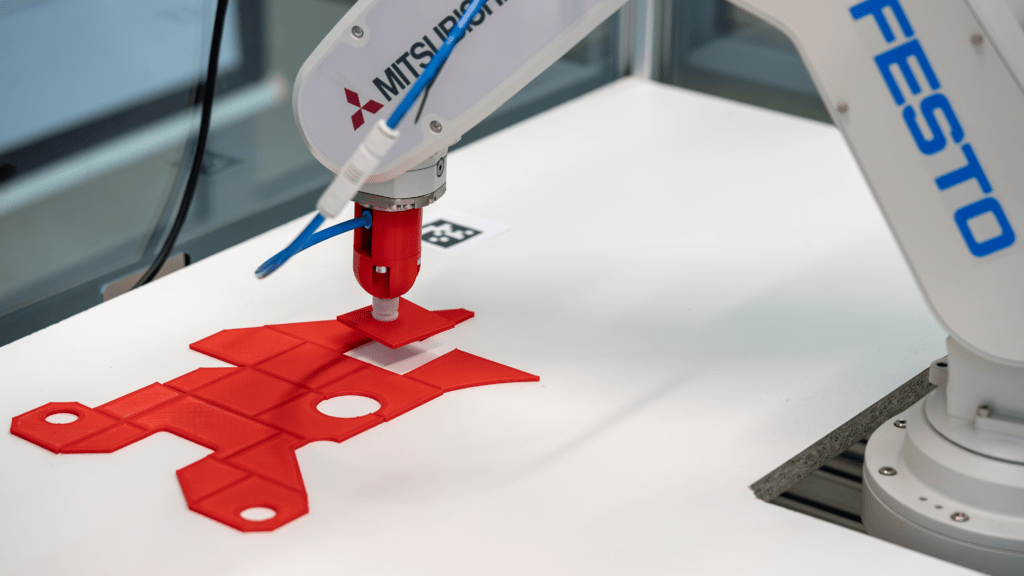
Zwei IDS Industriekameras liefern die nötigen Bildinformationen
Mithilfe von zwei uEye XC Kameras und einer KI-gestützten Bildverarbeitung analysiert das System die Umgebung und berechnet präzise Aufnahme- sowie Ablagekoordinaten. Eine der Kameras wurde dazu über der Arbeitsfläche platziert, die andere über der Entnahmestelle. Konkret verarbeitet eine KI-Pipeline die Bilder der beiden Kameras in mehreren Schritten, um die exakte Lage und Ausrichtung der Objekte zu bestimmen. Mithilfe der Computer-Vision-Algorithmen und neuronalen Netzen erkennt das System relevante Merkmale, berechnet die optimalen Greifpunkte und generiert präzise Koordinaten für die Aufnahme und Ablage der Objekte. Zudem identifiziert das System die Teile eindeutig, indem es ihre Oberfläche segmentiert und die Konturen mit einer Datenbank abgleicht. Darüber hinaus nutzt es die Ergebnisse, um eine Annäherung an bereits abgelegte Teile zu ermöglichen. Die Automatisierungslösung reduziert damit die Abhängigkeit von Expertenwissen, verkürzt Prozesszeiten und wirkt dem Fachkräftemangel entgegen.
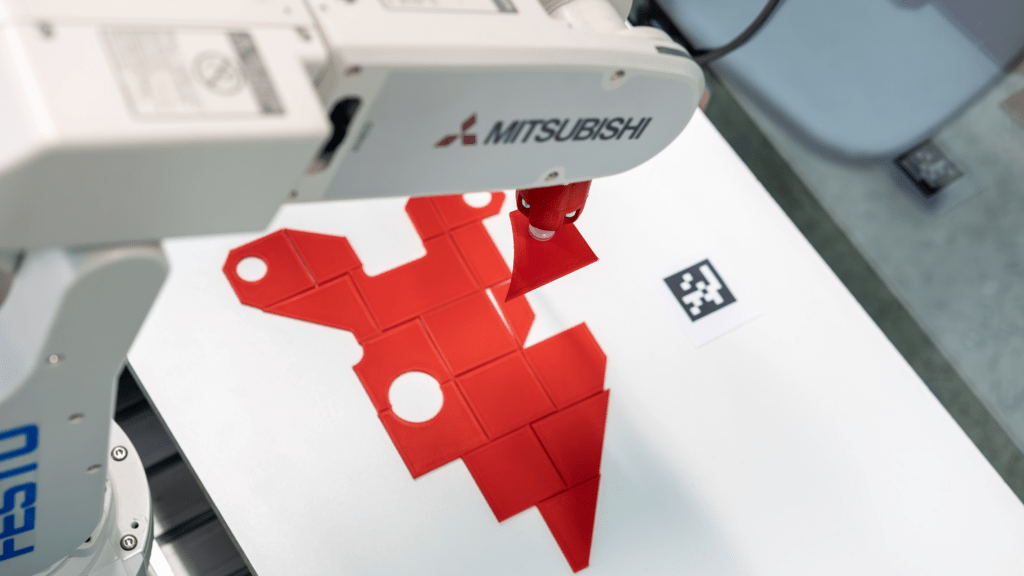
Kameraanforderungen
Schnittstelle, Sensor, Baugröße und Preis waren die Kriterien, die für die Wahl des Kameramodells entscheidend waren. Die uEye XC kombiniert die Benutzerfreundlichkeit einer Webcam mit der Leistungsfähigkeit einer Industriekamera. Sie erfordert lediglich eine Kabelverbindung für den Betrieb. Ausgestattet mit einem 13-MP-onsemi-Sensor (AR1335) liefert die Autofokus-Kamera hochauflösende Bilder und Videos. Eine wechselbare Makro-Aufsatzlinse ermöglicht eine verkürzte Objektdistanz, wodurch die Kamera auch für Nahbereichsanwendungen geeignet ist. Auch ihre Einbindung war denkbar einfach, wie Raphael Seliger, Wissenschaftlicher Mitarbeiter der Hochschule Kempten, erklärt: „Wir binden die Kameras über die IDS peak Schnittstelle an unser Python Backend an.“
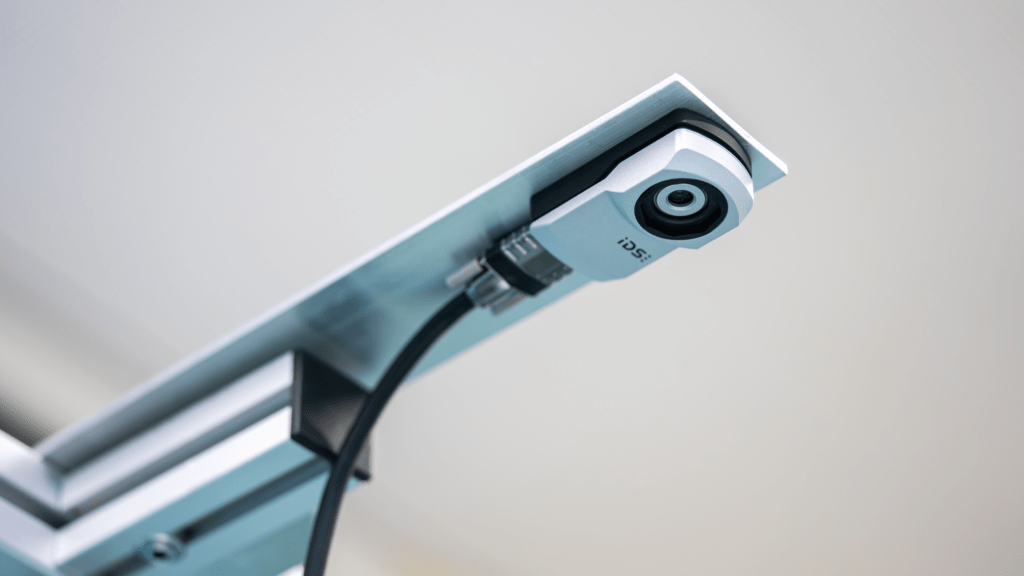
Ausblick
Zukünftig soll das System durch Reinforcement Learning weiterentwickelt werden – einer Methode des maschinellen Lernens, die auf Lernen durch Versuch und Irrtum beruht. „Wir möchten gerne die KI-Funktionen ausbauen, um die Pick-and-Place Vorgänge intelligenter zu gestalten. Unter Umständen benötigen wir dafür eine zusätzliche Kamera direkt am Roboterarm“, erläutert Seliger. Geplant ist zudem eine automatische Genauigkeitsprüfung der abgelegten Teile. Langfristig soll der Roboter allein anhand der Montagezeichnung alle erforderlichen Schritte eigenständig ausführen können.
Creativity in motion: The modular robot Otto from HP Robots
The HP Robots Otto is a versatile, modular robot designed specifically for educational purposes. It offers students and teachers an exciting opportunity to immerse themselves in the world of robotics, 3D printing, electronics and programming. The robot was developed by HP as part of their robotics initiative and is particularly suitable for use in science, technology, engineering and mathematics (STEM) classes.
Key features of Otto:
- Modular design: Otto is a modular robot that allows students to build, program and customize it through extensions. This promotes an understanding of technology and creativity. The modular structure allows various components such as motors, sensors and LEDs to be added or replaced, which increases the learning curve for students.
- Programmability: The robot can be programmed with various programming languages, including block-based programming for beginners and Python and C++ for advanced programmers. This diversity allows students to continuously improve their coding skills and adapt to the complexity of the tasks.
- Sensors and functions: Equipped with ultrasonic sensors for obstacle detection, line tracking sensors and RGB LEDs, Otto offers numerous interactive possibilities. These features allow students to program complex tasks such as navigating courses or tracing lines. The sensors help to detect the environment and react accordingly.
- 3D printing and customizability: Students can design Otto’s outer parts themselves and produce them with a 3D printer. This allows for further personalization and customization of the robot. This creative freedom not only promotes technical understanding, but also artistic skills. Own parts can be designed and sensors can be attached to desired locations.
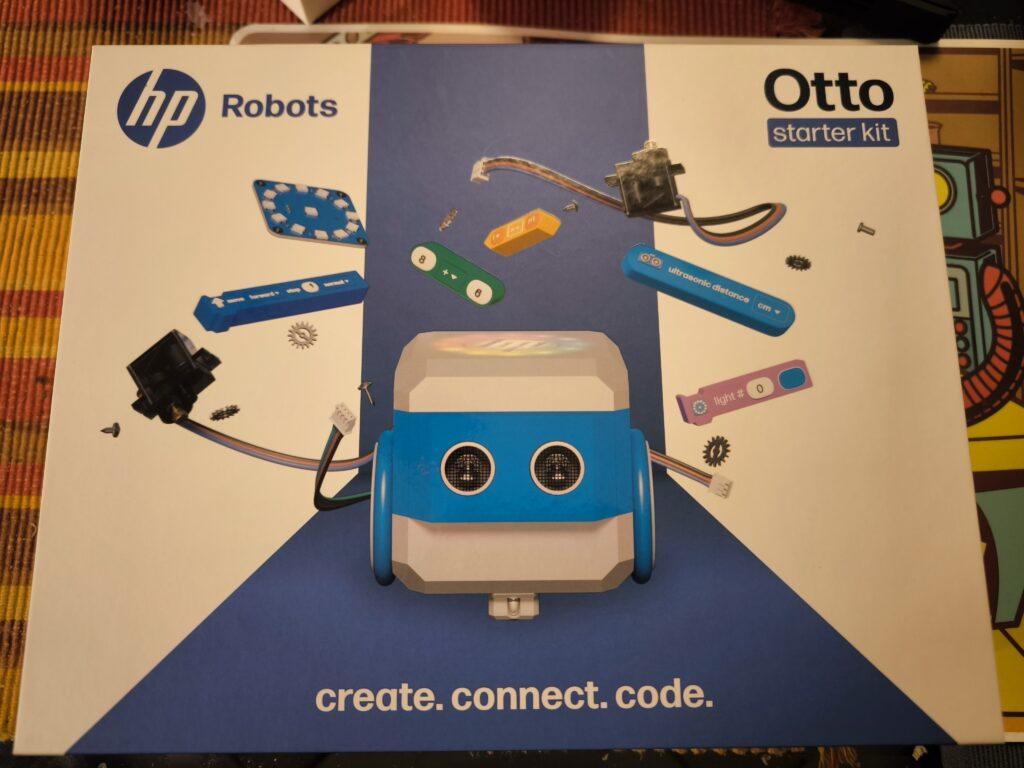
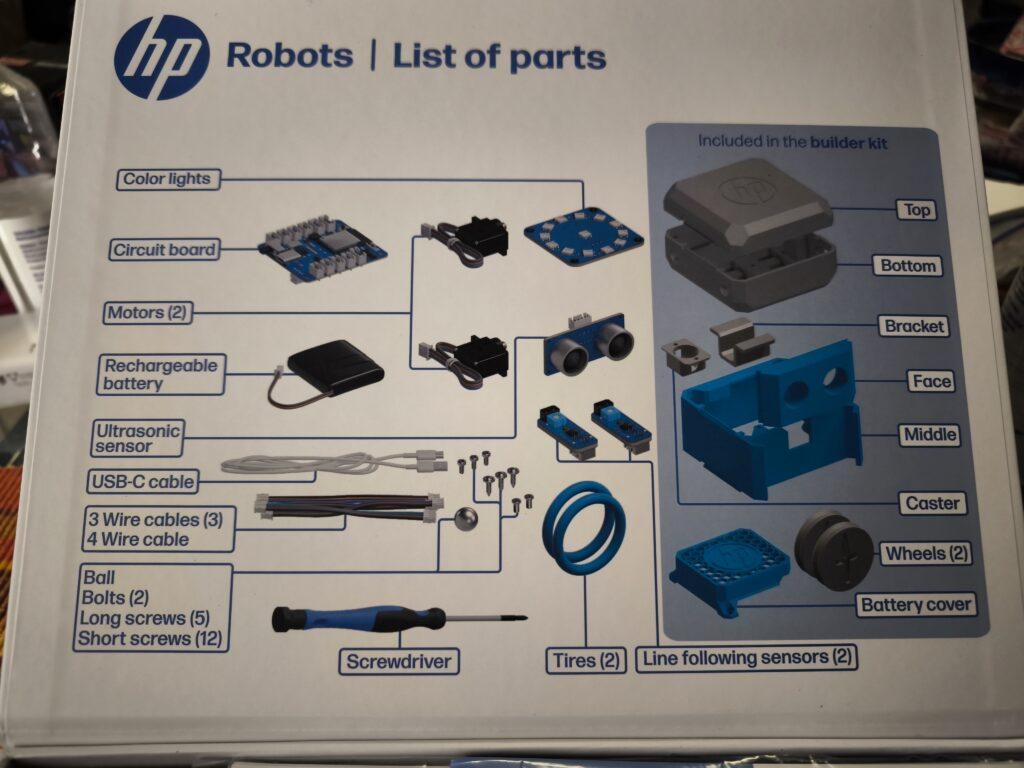
Educational approach:
Otto is ideal for use in schools and is aimed at students from the age of 8. Younger students can work under supervision, while older students from the age of 14 can also use and expand the robot independently. The kit contains all the necessary components to build a functioning robot, including motors, sensors, and a rechargeable battery.
Programming environments:
Otto is programmed via a web-based platform that runs on all operating systems. This platform offers different modes:
- Block-based programming: Similar to Scratch Jr., ideal for beginners. This visual programming makes it easier to get started in the world of programming and helps students understand basic concepts such as loops and conditions.
- Python: A Python editor is available for advanced users. Python is a popular language that works well for teaching because it is easy to read and write. Students can use Python to develop more complex algorithms and expand their programming skills.
- C++: Compatible with the Arduino IDE for users who have deeper programming knowledge. C++ offers a high degree of flexibility and allows students to access the hardware directly, allowing for their own advanced projects.
Expansion Kits:
In addition to the Starter Kit, there are several expansion kits. All expansion kits require the starter kit, as they are built on top of it.
Emote Expansion Kit:
- It includes components such as an LED matrix display, OLED display, and an MP3 player that allow the robot to display visual and acoustic responses.
- This kit is particularly suitable for creative projects where Otto should act as an interactive companion.
- The emote kit allows Otto to show emotions, mirror human interactions, and develop different personalities.
Sense Expansion Kit:
- With the Sense Kit, Otto can perceive its surroundings through various sensors.
- Included are sensors for temperature, humidity, light and noise as well as an inclination sensor. These enable a wide range of interactions with the environment.
- The kit is ideal for projects that focus on environmental detection and data analysis.
Interact Expansion Kit:
- The Interact kit expands Otto’s tactile interaction capability through modules such as push buttons, rotary knobs and accelerometers.
- It enables precise inputs and reactions, as well as measurement of acceleration.
- This kit is great for playful activities and interactive games.

Invent Expansion Kit:
- The Invent kit is specifically designed to encourage users‘ creativity. It allows the individual adaptation of Otto’s functionalities and design through 3D printing and additional modules as well as compatible clamping blocks.
- Users can design and print new accessories to make the robot unique.
- Equip Otto with legs and teach him to walk or make him fit for outdoor use off-road with chains.
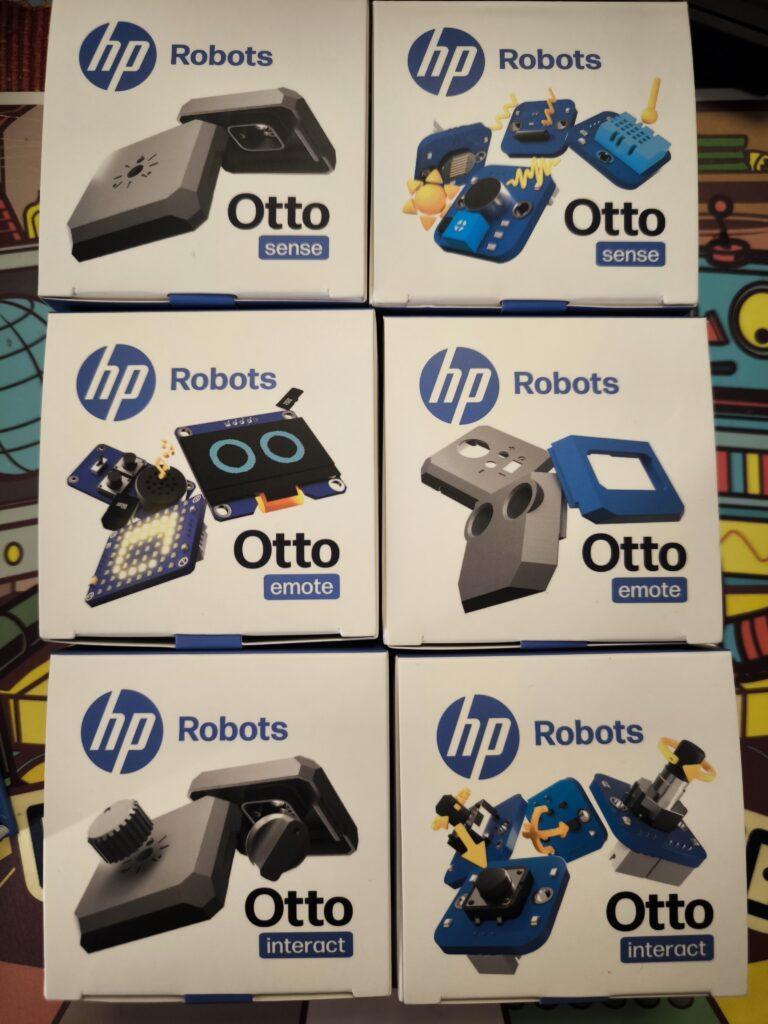
Use in the classroom:
Otto comes with extensive resources developed by teachers. These materials help teachers design effective STEM lessons without the need for prior knowledge. The robot can be used both in the classroom and at home. The didactic materials include:
- Curricula: Structured lesson plans that help teachers plan and execute lessons.
- Project ideas and worksheets: A variety of projects that encourage students to think creatively and expand their skills.
- Tutorials and videos: Additional learning materials to help students better understand complex concepts.
Conclusion:
The HP Robots Otto is an excellent tool for fostering technical understanding and creativity in students. Thanks to its modular design and diverse programming options, it offers a hands-on learning experience in the field of robotics and electronics. Ideal for use in schools, Otto provides teachers with a comprehensive platform to accompany students on an exciting journey into the world of technology. In particular, Otto’s versatility through the 3D-printed parts and expansion packs offers the opportunity to build the personal learning robot.
Kreativität in Bewegung: Der modulare Roboter Otto von HP Robots
Der HP Robots Otto ist ein vielseitiger, modularer Roboter, der speziell für Bildungszwecke entwickelt wurde. Er bietet Schülern und Lehrern eine spannende Möglichkeit, in die Welt der Robotik, 3D-Druck, Elektronik und Programmierung einzutauchen. Der Roboter wurde von HP als Teil ihrer Robotik-Initiative entwickelt und ist besonders für den Einsatz im MINT-Unterricht (Mathematik, Informatik, Naturwissenschaften und Technik) geeignet.
Hauptmerkmale von Otto:
- Modularer Aufbau: Otto ist ein modularer Roboter, der es Schülern ermöglicht, ihn zu bauen, zu programmieren und durch Erweiterungen individuell anzupassen. Dies fördert das Verständnis für Technik und Kreativität. Die modulare Struktur erlaubt es, verschiedene Komponenten wie Motoren, Sensoren und LEDs hinzuzufügen oder zu ersetzen, was die Lernkurve für Schüler erweitert.
- Programmierbarkeit: Der Roboter kann mit verschiedenen Programmiersprachen programmiert werden, darunter blockbasierte Programmierung für Anfänger sowie Python und C++ für Fortgeschrittene. Diese Vielfalt ermöglicht es Schülern, ihre Programmierfähigkeiten kontinuierlich zu verbessern und sich an die Komplexität der Aufgaben anzupassen.
- Sensoren und Funktionen: Ausgestattet mit Ultraschallsensoren zur Hinderniserkennung, Linienverfolgungssensoren und RGB-LEDs bietet Otto zahlreiche interaktive Möglichkeiten. Diese Funktionen ermöglichen es Schülern, komplexe Aufgaben wie das Navigieren durch Parcours oder das Verfolgen von Linien zu programmieren. Die Sensoren helfen dabei, die Umgebung zu erkennen und entsprechend zu reagieren.
- 3D-Druck und Anpassbarkeit: Schüler können Ottos äußere Teile selbst entwerfen und mit einem 3D-Drucker herstellen. Dies ermöglicht eine weitere Personalisierung und Anpassung des Roboters. Diese Kreativfreiheit fördert nicht nur technisches Verständnis, sondern auch künstlerische Fähigkeiten. Eigene Teile können entworfen und Sensoren an gewünschten Stellen angebracht werden.


Bildungsansatz:
Otto ist ideal für den Einsatz in Schulen gedacht und richtet sich an Schüler ab 8 Jahren. Jüngere Schüler können unter Aufsicht arbeiten, während ältere Schüler ab 14 Jahren den Roboter auch eigenständig nutzen und erweitern können. Das Kit enthält alle notwendigen Komponenten, um einen funktionierenden Roboter zu bauen, einschließlich Motoren, Sensoren und einer wiederaufladbaren Batterie.
Programmierumgebungen:
Die Programmierung von Otto erfolgt über eine webbasierte Plattform, die auf allen Betriebssystemen läuft. Diese Plattform bietet verschiedene Modi:
- Blockbasierte Programmierung: Ähnlich wie Scratch Jr., ideal für Anfänger. Diese visuelle Programmierung erleichtert den Einstieg in die Welt der Programmierung und hilft Schülern, grundlegende Konzepte wie Schleifen und Bedingungen zu verstehen.
- Python: Für fortgeschrittene Benutzer steht ein Python-Editor zur Verfügung. Python ist eine beliebte Sprache, die sich gut für den Unterricht eignet, da sie einfach zu lesen und zu schreiben ist. Schüler können mit Python komplexere Algorithmen entwickeln und ihre Fähigkeiten im Bereich der Programmierung erweitern.
- C++: Kompatibel mit der Arduino IDE für Nutzer, die tiefere Programmierkenntnisse haben. C++ bietet eine hohe Flexibilität und ermöglicht es Schülern, direkt auf die Hardware zuzugreifen, was eigene fortgeschrittene Projekte ermöglicht.
Expansion/Erweiterungs Kits:
Zusätzlich zum Starter Kit gibt es mehrere Erweiterungskits. Alle Erweiterungskits setzen das Starter-Kit voraus, da sie auf dessen Basis aufgebaut werden.
Emote Expansion Kit:
- Es enthält Komponenten wie ein LED-Matrix-Display, OLED Display und einen MP3-Player, die es dem Roboter ermöglichen, visuelle und akustische Reaktionen darzustellen.
- Dieses Kit eignet sich besonders für kreative Projekte, bei denen Otto als interaktiver Begleiter fungieren soll.
- Das Emote-Kit ermöglicht es Otto, Emotionen zu zeigen, menschliche Interaktionen zu spiegeln und verschiedene Persönlichkeiten zu entwickeln.
Sense Expansion Kit:
- Mit dem Sense-Kit kann Otto seine Umgebung durch verschiedene Sensoren wahrnehmen.
- Enthalten sind Sensoren für Temperatur, Luftfeuchtigkeit, Licht und Geräusche sowie ein Neigungssensor. Diese ermöglichen vielfältige Interaktionen mit der Umwelt.
- Das Kit ist ideal für Projekte, die sich auf Umwelterkennung und Datenanalyse konzentrieren.
Interact Expansion Kit:
- Das Interact-Kit erweitert Ottos Fähigkeit zur taktilen Interaktion durch Module wie Drucktasten, Drehknöpfe und Beschleunigungsmesser.
- Es ermöglicht präzise Eingaben und Reaktionen sowie Messung der Beschleunigung.
- Dieses Kit eignet sich hervorragend für spielerische Aktivitäten und interaktive Spiele.
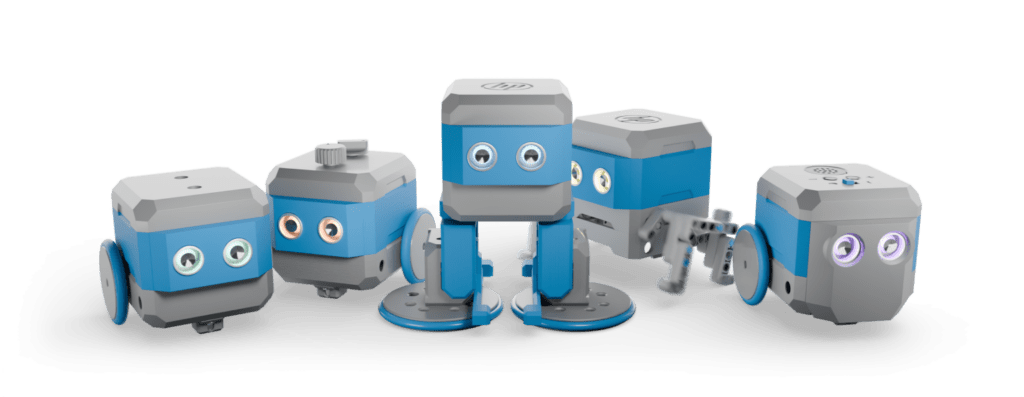
Invent Expansion Kit:
- Das Invent-Kit ist speziell darauf ausgelegt, die Kreativität der Benutzer zu fördern. Es erlaubt die individuelle Anpassung von Ottos Funktionalitäten und Design durch 3D-Druck und zusätzliche Module sowie kompatible Klemmbausteine.
- Benutzer können neue Zubehörteile entwerfen und drucken, um den Roboter einzigartig zu machen.
- Statte Otto mit Beinen aus und bring ihm das Laufen bei oder mache ihn mit Ketten fit für den Outdoor Einsatz im Gelände.

Einsatz im Unterricht:
Otto wird mit umfangreichen Ressourcen geliefert, die von Lehrern entwickelt wurden. Diese Materialien unterstützen Lehrer dabei, einen effektiven MINT-Unterricht zu gestalten, ohne dass Vorkenntnisse erforderlich sind. Der Roboter kann sowohl im Klassenraum als auch zu Hause eingesetzt werden. Die didaktischen Materialien umfassen:
- Lehrpläne: Strukturierte Unterrichtspläne, die den Lehrern helfen, den Unterricht zu planen und durchzuführen.
- Projektideen und Arbeitsblätter: Eine Vielzahl von Projekten, die Schüler dazu anregen, kreativ zu denken und ihre Fähigkeiten zu erweitern.
- Tutorials und Videos: Zusätzliche Lernmaterialien, die Schülern helfen, komplexe Konzepte besser zu verstehen.
Fazit:
Der HP Robots Otto ist ein hervorragendes Werkzeug zur Förderung von technischem Verständnis und Kreativität bei Schülern. Durch seine modulare Bauweise und die vielfältigen Programmiermöglichkeiten bietet er eine praxisorientierte Lernerfahrung im Bereich der Robotik und Elektronik. Otto ist ideal für den Einsatz in Schulen und bietet Lehrern eine umfassende Plattform, um Schüler auf eine spannende Reise in die Welt der Technologie zu begleiten. Besonders Ottos Vielseitigkeit durch die 3D-gedruckten Teile und Erweiterungspakete bieten die Möglichkeit, den persönlichen Lernroboter zu bauen.
RoboCup Junior Generalprobe und Eröffnung der RBTX Academy: Roboter-Wissen to-go mit Trainings von igus
Köln, 28. Januar 2025 – Roboter werden in immer mehr Bereichen eingesetzt, von der Produktion in Fabriken bis hin zur Pflege von älteren Menschen. Um Unternehmen jeder Größe zu ermöglichen, das volle Potenzial von Automationslösungen auszuschöpfen und so wettbewerbsfähiger zu werden, eröffnet igus jetzt die RBTX Academy. Hier können Interessierte direkt an echten Robotern arbeiten, um die Grundlagen der Robotertechnik zu erlernen oder ihre Fähigkeiten in der Roboterprogrammierung zu vertiefen. Zum ersten Mal öffnete die RBTX Academy ihre Pforten am 25. Januar als igus auf dem Werksgelände in Köln Porz-Lind die Generalprobe für den RoboCup Junior 2025 veranstaltete – einer der bekanntesten und größten Robotik-Wettbewerbe für Schülerinnen und Schüler weltweit.
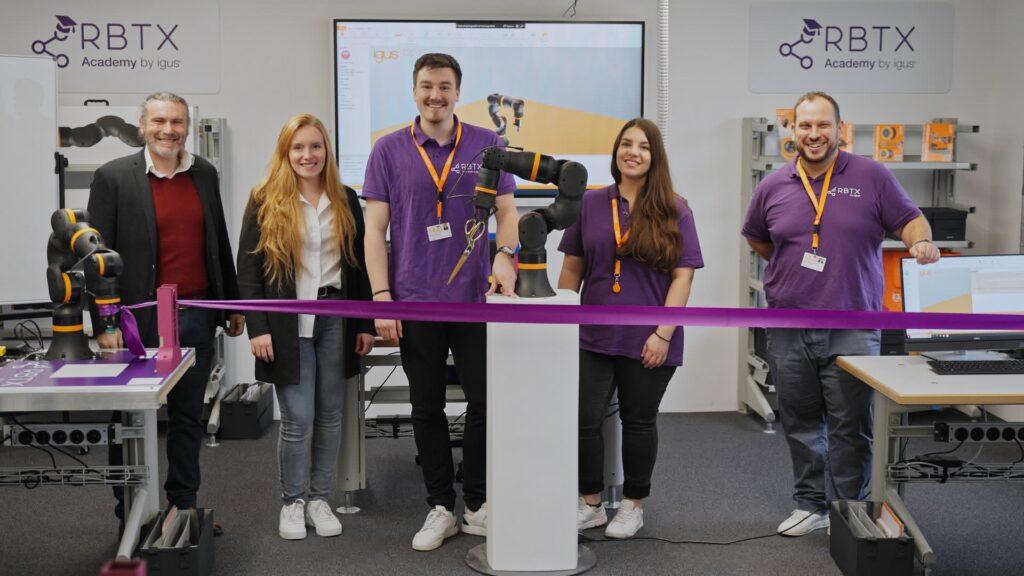
Roboter sind immer weniger Privileg von Großunternehmen mit ausreichend Know-how und Budget. Auch kleinen und mittelständischen Unternehmen gelingt die Automations-Transformation dank des Marktplatzes RBTX von igus, der kostengünstige und schlüsselfertige Robotiklösungen bietet. Um Betrieben den Einsatz solcher Lösungen weiter zu vereinfachen, hat igus am 25. Januar 2025 die RBTX Academy eröffnet. „Kunden, die einen Low-Cost-Roboter über unseren Marktplatz kaufen, können ab sofort Schulungen buchen, um die Roboterprogrammierung von Grund auf zu erlernen oder ihre Fähigkeiten weiter zu vertiefen“, sagt Alexander Mühlens, Prokurist und Leiter Geschäftsbereich Low-Cost-Automation bei igus. „Die praxisnahen Trainings finden bei uns in Köln in kleinen Gruppen in familiärer Atmosphäre statt und sind auf die individuellen Bedürfnisse der Teilnehmenden zugeschnitten, um größtmöglichen Nutzen zu bieten. Wir werden das Angebot zudem an weiteren Standorten wie München und Osnabrück sowie international in Ländern wie den USA, China, Großbritannien, Italien und Spanien ausrollen.“ Interessenten können sich ab sofort über die Website von igus anmelden. Zeitgleich fand die Generalprobe für den RoboCup Junior 2025 statt, dessen Besucherinnen und Besucher die Academy bereits kennenlernen konnten. igus gibt mit der Generalprobe Schülerinnen und Schülern die Möglichkeit, ihre selbstentwickelten Roboter in einer Wettkampfsituation zu testen, bevor es zum NRW-Qualifikationsturnier geht. Robotik-Experten von igus stehen ihnen zur Seite, um letzte technische Fehler zu finden und Optimierungen vorzunehmen.
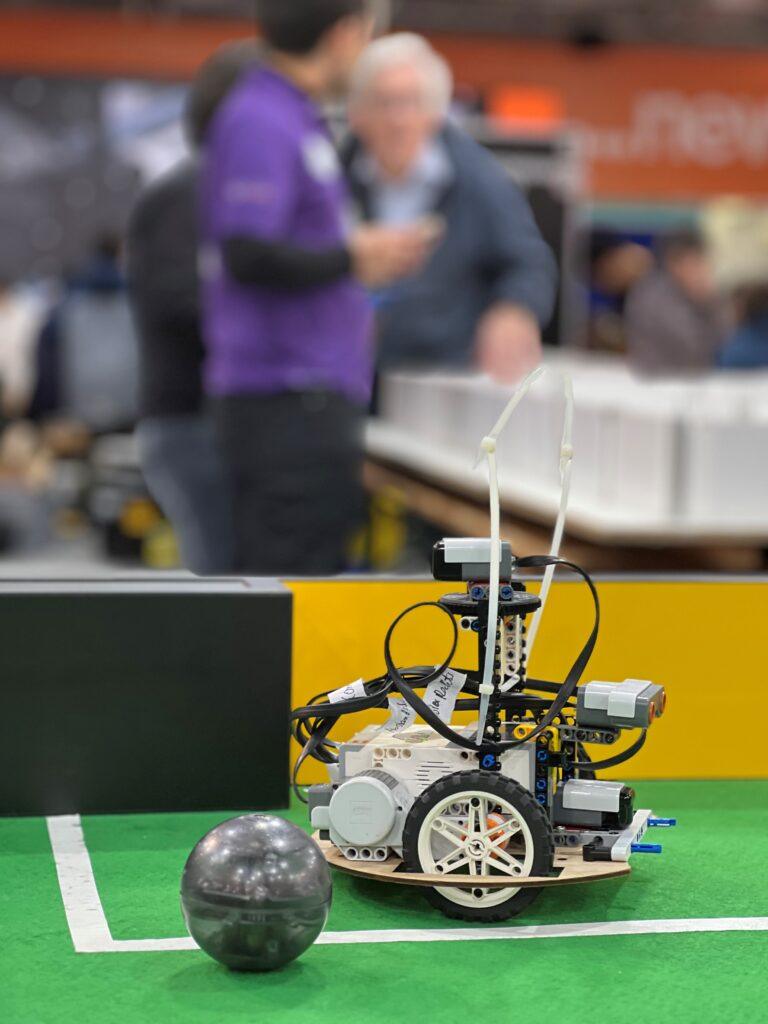
Vom einfachen Bewegungsablauf bis zur komplexen Integration in Systemlandschaften
In den praxisnahen Schulungen der RBTX Academy lernen die Teilnehmenden zum Beispiel den Umgang mit der Steuerungssoftware igus Robot Control. Die Software erstellt einen virtuellen Zwilling des Roboters, der in Echtzeit Bewegungen und Aktionen simuliert. So lassen sich über eine benutzerfreundliche Oberfläche Bewegungsabläufe planen, testen und optimieren. Die Programme können dann im nächsten Schritt an den realen Roboter übertragen werden, der die Aufgaben präzise ausführt – etwa am Gelenkarmroboter ReBeL Cobot, der zu einem Großteil aus Hochleistungskunststoff gefertigt ist und dadurch nur 4.970 Euro kostet. „Diese Methode ermöglicht eine effiziente Automatisierung selbst für Einsteiger. Sie können die ersten einfachen Bewegungsabläufe in der Regel innerhalb einer Stunde erstellen“, so Mühlens. Igus bietet aber auch Expertentrainings an, um tiefer in die Programmierung einzusteigen. „Teilnehmende lernen dadurch beispielsweise, Low-Cost-Roboter in komplexe Automationsumgebungen einzubinden und mit anderen Systemen interagieren zu lassen.“ Neben der igus Robot Control können die Kursteilnehmenden dabei auch mit Steuerungen anderer Hersteller trainieren – darunter Epson, Universal Robot und Dobot.
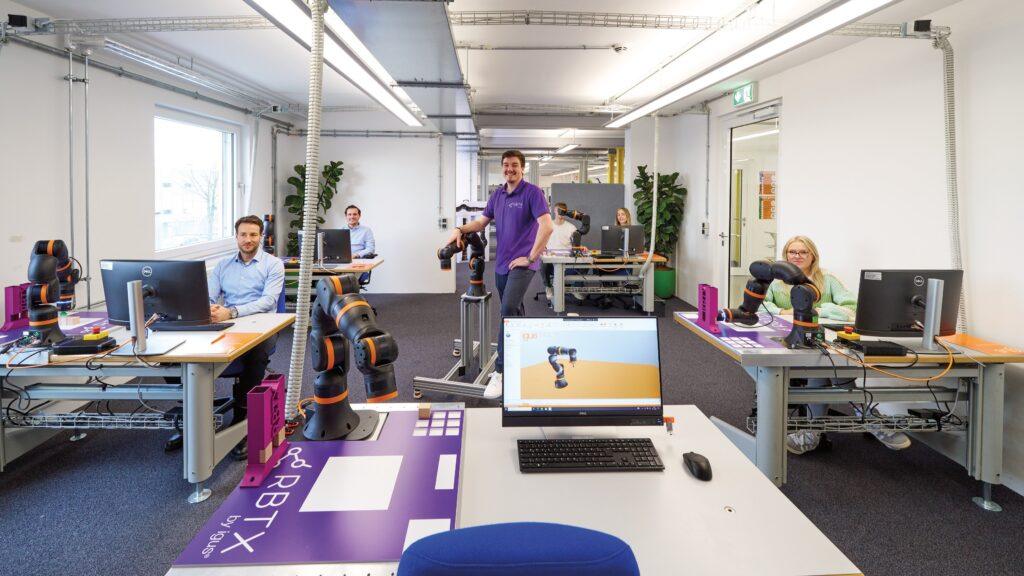
Show-Room mit Low-Cost-Robotics bietet Inspiration für zukünftige Automationsprojekte
Während des Trainings haben sie zudem die Möglichkeit, die 400 Quadratmeter große Customer Testing Area zu besuchen. Dort präsentiert igus eine Auswahl an Robotik-Anwendungen mit Produkten von über 130 führenden Herstellern, die sich auch online auf dem RBTX-Marktplatz finden. Denn ein Roboter allein macht noch keine fertige Lösung. Von Pick-and-Place am Förderband mit einem SCARA-Roboter über Klebe-Arbeiten mit einem Portalroboter bis hin zum ReBeL Cobot als Barista können Besucher verschiedenste Anwendungsfälle vor Ort erleben. Die Besonderheit: Alle Komponenten auf RBTX.com werden vorab miteinander kombiniert und Kompatibilitätstests durchgeführt, sodass Anwender bei jeder Konfiguration auf der sicheren Seite sind und die passende Lösung für ihre individuelle Anwendung finden. „Unser Motto lautet dabei: ‚Automatisiere deine Fabrik ab 2.000 Euro“. Heißt, wir fokussieren uns stets auf bezahlbare Robotiklösungen“, betont Mühlens.
RoboCup Rescue mit Open Roberta – Anleitung und benötigte JSON Dateien
Die RoboCup Junior-Community kann sich freuen: Ab sofort steht euch das Open Roberta Lab in einer speziell angepassten Umgebung zur Verfügung, um euch optimal auf den RoboCup Rescue vorzubereiten.Mit den neuen Tools und Features könnt ihr:
- Effizient trainieren
- Eure Algorithmen testen
- Kontinuierlich Verbesserungen vornehmen
Einfach hier starten: RCJ RescueOnlineSim im Open Roberta Lab auswählen.
Warum ist das wichtig?Der RoboCup Junior ist eine der spannendsten Herausforderungen für junge Robotik-Talente. Ziel ist es, autonome Roboter in realistischen Rettungsszenarien einzusetzen. Dabei stehen folgende Fähigkeiten im Fokus:
- Präzision und Zuverlässigkeit: Hindernisse überwinden und Opfer identifizieren.
- Effiziente Navigation: Linien folgen und komplexe Strecken meistern.
- Realistische Simulationen: Mit den neuesten Features von Open Roberta.
Mehr erfahren?Weitere Informationen findet ihr hier: junior.robocup.de
Jetzt starten und die Zukunft der Robotik erleben!Wenn du Teil der nächsten Generation innovativer Robotiker*innen sein möchtest, ist Open Roberta die ideale Plattform, um loszulegen. Schau dir das inspirierende Video an und lass dich begeistern!Ein besonderer Dank geht an Beate Jost und ihr Team, die diese neue Entwicklung im Open Roberta Lab ermöglicht haben, sowie an Gerald Steinbauer-Wagner für den wertvollen Austausch!
Hier findet ihr die benötigten JSON Dateien zum Download, sowie die dazugehörige Anleitung:
Anleitung_OpenRoberta_RCJ_Rescue.pdf
Hier auch nochmal die Anleitung:
Anleitung zur Einbindung der Simulationsumgebung im Open Roberta Lab
Mit der Simulationsumgebung im Open Roberta Lab kannst du Programme für den RoboCup Rescue testen und optimieren. Befolge diese Schritte, um die Umgebung einzurichten:
1. Gehe zu https://lab.open-roberta.org
Rufe die Webseite des Open Roberta Labs auf.

👉 Screenshot 1: (RCJ RescueOnlineSim-Kachel mit „Loslegen“-Button).
2. Wähle die RCJ RescueOnlineSim-Option aus
- Suche nach der RCJ RescueOnlineSim-Kachel.
- Klicke auf „Loslegen“.
3. Schreibe dein Programm
- Nutze die Programmierblöcke im Editor, um die Steuerung deines Roboters zu definieren.
- Du kannst Befehle wie „Fahren“, „Sensoren“ oder „Logik“ verwenden, um den Roboter für Rettungsszenarien zu programmieren.

👉 Screenshot 2: (Editor mit sichtbaren Blöcken und Programmieroptionen).
4. Klicke auf SIM
- Öffne die Simulationsansicht, indem du auf SIM (rechts im Menü) klickst.

👉 Screenshot 3: (SIM-Button rechts im Open Roberta Lab hervorgehoben).
5. Lade eine Umgebung hoch
- Wähle eine der beiden Rettungsumgebungen aus, die du vorbereitet hast:
- AustrianOpen24-Entry1.json
- AustrianOpen24-Entry2.json
- Lade die gewünschte Umgebung in die Simulation.

👉 Screenshot 4: (Anzeige des Upload-Prozesses der Umgebungen).
6. Starte mit dem Testen
- Klicke auf den Start-Button in der Simulation, um dein Programm zu testen.

👉 Screenshot 5: (Simulationsumgebung mit Roboter auf der Karte).
7. Test-Durchlauf starten
- Stopuhr verwenden: Mit einem Klick auf die Stopuhr startest du den Test-Durchlauf.
- Die Zeit wird gemessen, und die Punkteanzahl wird gezählt, basierend auf der Leistung des Roboters.

👉 Screenshot 6: (Stopuhr und Scoring-Funktion hervorgehoben).
Funktionen:
- Simulation in Echtzeit: Verfolge, wie dein Roboter Linien folgt, Hindernisse umgeht oder Aufgaben löst.
- Scoring-System: Die Simulation zeigt die Punkte und die Zeit an, um deine Leistung zu bewerten.
8. Weitere Informationen
- Integrierte Online-Hilfe: Nutze die integrierte Hilfefunktion, um mehr über die Programmierblöcke und Funktionen zu erfahren.

👉 Screenshot 7: (Integrierte Online-Hilfe hervorgehoben).
- Open Roberta Wiki: Vertiefte Informationen findest du im Open Roberta Wiki:
https://jira.iais.fraunhofer.de/wiki/spaces/ORInfo/pages/407961612/Set+Up+RCJ+RescueOnlineSim?showLanguage=de_DE.
Mit dieser Anleitung kannst du deine Programme optimal testen und dich auf Wettbewerbe wie den RoboCup Rescue vorbereiten. Viel Erfolg! 🚀
